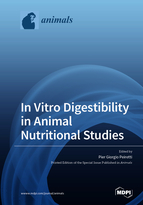In Vitro Digestibility in Animal Nutritional Studies
A special issue of Animals (ISSN 2076-2615). This special issue belongs to the section "Animal Nutrition".
Deadline for manuscript submissions: closed (28 February 2020) | Viewed by 79029
Special Issue Editor
Interests: animal nutrition; feed digestibility; food of animal origin
Special Issues, Collections and Topics in MDPI journals
Special Issue Information
Dear Colleagues,
The use of animals in research elicits a diverse range of attitudes and emotions, with some people demanding the abolition of research on animals and others expressing strong support. Typically, opponents of animal research cite animal welfare and suffering, as well as the uselessness of digestibility trials. In vitro techniques for feed evaluation are important methodologies for studying the physiology of certain segments of the digestive tract and the fermentative and digestive characteristics of feed.
Given the above, the trend is to prefer the use of in vitro enzymatic analysis over in vivo studies, which are more costly, laborious, and require animals anyway. Different closed-system fermentation apparatuses have been used in digestibility studies in ruminants and monogastric and companion animals. The incubators developed for multiple analyses of feeds have reduced labor demands and improved precision compared to traditional in vitro methods, which are time-consuming and imprecise. Furthermore, they could offer an alternative system to traditional in vivo methods, but further studies are needed to fully assess the potential of different methods and apparatuses in animal nutritional studies.
Original manuscripts, including reviews that address any aspects of in vitro digestibility in animal nutritional studies, are invited for this Special Issue.
Dr. Pier Giorgio Peiretti
Guest Editor
Manuscript Submission Information
Manuscripts should be submitted online at www.mdpi.com by registering and logging in to this website. Once you are registered, click here to go to the submission form. Manuscripts can be submitted until the deadline. All submissions that pass pre-check are peer-reviewed. Accepted papers will be published continuously in the journal (as soon as accepted) and will be listed together on the special issue website. Research articles, review articles as well as short communications are invited. For planned papers, a title and short abstract (about 100 words) can be sent to the Editorial Office for announcement on this website.
Submitted manuscripts should not have been published previously, nor be under consideration for publication elsewhere (except conference proceedings papers). All manuscripts are thoroughly refereed through a single-blind peer-review process. A guide for authors and other relevant information for submission of manuscripts is available on the Instructions for Authors page. Animals is an international peer-reviewed open access semimonthly journal published by MDPI.
Please visit the Instructions for Authors page before submitting a manuscript. The Article Processing Charge (APC) for publication in this open access journal is 2400 CHF (Swiss Francs). Submitted papers should be well formatted and use good English. Authors may use MDPI's English editing service prior to publication or during author revisions.
Keywords
- digestibility techniques
- gas production
- degradability
- fermentative characteristics
- digestive process
- enzyme
- DaisyII incubator
- rumen liquor
- gastric digestion







